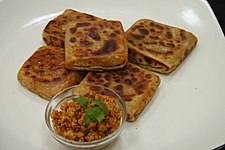Mughlai paratha
 Mughlai paratha made in Karnataka, India | |
| Type | Paratha |
|---|---|
| Course | Snack |
| Place of origin | Bengal Subah |
| Region or state | Bengal |
| Associated cuisine | Bangladesh, India |
| Main ingredients | Paratha, keema (minced meat), egg, ghee, onions, Indian spices, salt and pepper |
Mughlai paratha (Bengali: মোগলাই পরোটা, romanized: Moglai pôroṭa) is a popular Bengali street food consisting of a flatbread (paratha) wrapped around or stuffed with keema (spiced minced meat) and or egg.[1][2] It is believed to have originated in Bengal Subah during the time of the Mughal Empire as a derivative of the Turkish Gözleme.[3][4] The dish is believed to be prepared for the royal court of Mughal Emperor Jahangir.[5][6][7]
History[edit]
Mughlai paratha was one of those Mughlai recipes that entered Bengali cuisine during the Mughal Empire. It is believed that the Mughlai paratha originated during Mughal emperor Jahangir's reign and it was a creation of his cook Adil Hafiz Usman, who originally hailed from the Bardhaman district of West Bengal of Hadhrami Arab descent.[5] It is likely a derivative of the Turkish Gözleme.[8] Mughal rule mostly influenced the cuisine of the administrative capitals of Bengal Subah, like Murshidabad and Dhaka, rather than the rural part of it.[6] The dish traveled to Kolkata in West Bengal from old capitals of Bengal Subah like Murshidabad and Dhaka, after Kolkata became the capital of the newly formed Bengal presidency under British Raj and the dish became a very common and popular street snack of Kolkata.[4][9]
Ingredients[edit]
Ingredients in the preparation of Mughlai paratha may include whole-wheat flour, ghee, eggs, finely chopped onions, chopped green chili pepper and chopped coriander leaves.[10]
Sometimes chicken or mutton keema is also used in some variants. It can also be served without meat for stuffing.
See also[edit]
- Bangladeshi cuisine
- List of Bangladeshi dishes
- Indian cuisine
- List of Indian dishes
- List of street foods
References[edit]
- ^ Ahmad, F. (2013). "Bangladesh". In Kraig, Bruce; Sen, Colleen Taylor (eds.). Street Food around the World: An Encyclopedia of Food and Culture. ABC-CLIO. p. 43. ISBN 978-1-59884-955-4.
- ^ Sen, Colleen Taylor (2013). "India". In Kraig, Bruce; Sen, Colleen Taylor (eds.). Street Food around the World: An Encyclopedia of Food and Culture. ABC-CLIO. p. 180. ISBN 978-1-59884-955-4.
- ^ Bora, Anirban. "From crispy 'parathas' to flavourful 'qormas': Debunking the many myths of Mughlai cuisine". The Economic Times. Retrieved 25 September 2020.
- ^ a b "Was it the British who named Kolkata's favourite Mughlai paratha?". Get Bengal. Retrieved 24 September 2020.
The Turks introduced Indians to Gözleme, a delicious traditional Turkish savoury. It is a flatbread recipe stuffed with spiced and minced lamb or beef filling. It is somewhat similar to Mughlai paratha and can be called the precursor of Mughlai Parantha itself.
- ^ a b "Mughlai Paratha: We Bet You Can't Resist This Meat Filled Deep-Fried Egg Paratha from Bengal". NDTV Food. 7 July 2017. Retrieved 24 September 2020.
Food Critic Bikramjeet Ray sees a lot of similarities between the Mughlai paratha and the Arabic or Lebanese breads, where you find a square-shaped and deep fried bread or wrap stuffed with meat.
- ^ a b Food Consumption in Global Perspective. Palgrave Macmillan. 23 July 2014. p. 172. ISBN 9781137326416.
- ^ "Try Kolkata street food this Durga Puja". The Times of India.
- ^ "Was it the British who named Kolkata's favourite Mughlai paratha?". Get Bengal. Retrieved 21 April 2022.
The Turks introduced Indians to Gözleme, a delicious traditional Turkish savoury. It is a flatbread recipe stuffed with spiced and minced lamb or beef filling. It is somewhat similar to Mughlai paratha and can be called the precursor of Mughlai Parantha itself.
- ^ Bora, Anirban. "From crispy 'parathas' to flavourful 'qormas': Debunking the many myths of Mughlai cuisine". The Economic Times. Retrieved 24 September 2020.
- ^ "Mughlai Paratha". NDTV Food.
